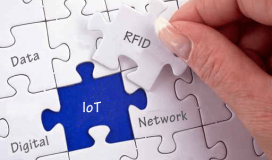RFID – radio frequency identification – completed its 60 years of use. Nowadays, consumers use this technology in several forms. For instance, in the form of identity cards they are used by employees to attain access to their respective departments and they are also used as payment cards that don’t need to be swiped through a machine. As RFID is more and more used in people’s daily lives, it’s significant to recognize what it is and how it works. RFID is a wireless technology that is used for radio identification of things. It characteristically involves 3 components: a tag, a reader, and a computer system.
Occasionally referred to as a transponder, the tag comprises of a microchip and a radio antenna. The chip in the tag contains information about the item that it is either enclosed or that it is entrenched in. The tag transmits that data to the reader using radio signals. RFID tag information can vary from a unique identity number to thousands of bytes of data. There are certain numbers of RFID tags available like Active RFID tags and Passive RFID tags.
Active RFID tags are special tags that consist of a reader, tag and antenna. Dissimilar to passive RFID tags that contain just an antenna and a microchip with no inner power basis, an active RFID tag has its own control source, an on-board, abiding battery that allows the tag to transmit data incessantly, in spite of whether it's in the field range of a reader. As the active tag market grows, disposable batteries will be a cost saving option. The system’s working depends completely on the type of tag selected for the application. The active tags are further classified into transponders and beacons.
They are tasked with climatic cruel environmental circumstances such as tremendous temperatures and damp, most active RFID tags are covered in a rugged shell. They tend to be bigger than passive tags. In addition, active tags may involve sensors that track environmental structures. These sensors can track , temperature, moisture levels, and other type identifiers that a business can use for their application.
Industries that frequently use active RFID tags as well to shipping andlogistics include automobile, sales industrializing, health and medical, construction, mining, isolated monitoring and IT asset organization. The main reasons Active RFID tags are preferred over passive are they have a longer read range, larger data storage capacity, fast data transfers, low cost and high security.



